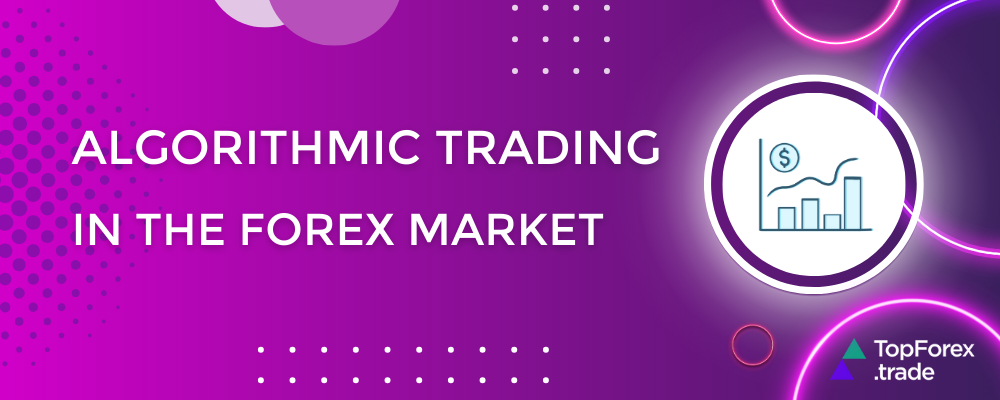Forex algorithmic trading: definitions, examples, and Top FX brokers

In the dynamic world of Forex algorithmic trading, technology intersects with finance to redefine trading strategies. This article delves into the fundamentals of algorithmic trading in Forex, showcasing real-world examples and highlighting leading FX brokers facilitating algorithmic strategies.
Algorithmic trading in Forex leverages technology and mathematical models to execute trades swiftly and accurately. We’ll explore practical examples illustrating how algorithms exploit market inefficiencies and manage risks in real-time trading.
Furthermore, we’ll navigate the landscape of top FX brokers offering robust algorithmic trading platforms. By examining their features, strengths, and limitations, traders can make informed decisions aligned with their objectives and preferences.
What is FX algorithmic trading?

Algorithmic trading, often referred to as algo trading or automated trading, is a method of executing trades in financial markets using computer algorithms. These algorithms are pre-programmed sets of instructions that dictate when to enter or exit trades based on various factors such as price, volume, market indicators, or other quantitative data.
Algorithmic trading aims to remove human emotions and biases from the trading process, relying instead on mathematical models and automated decision-making. By executing trades automatically according to predefined rules, algorithmic trading seeks to achieve objectives such as maximizing profits, minimizing risk, or capturing market inefficiencies.
Overall, algorithmic trading has become increasingly prevalent in financial markets, particularly in highly liquid markets such as stocks, futures, options, and foreign exchange. It offers benefits such as increased efficiency, reduced transaction costs, and the ability to simultaneously execute trades across multiple markets. However, it also poses challenges such as the need for robust infrastructure, ongoing monitoring, and the potential for unforeseen technical glitches or market disruptions.
Algorithmic trading example

Let’s consider another example of how algorithmic trading works:
Suppose a trader wants to implement a simple mean reversion strategy for a stock. The trader decides to buy the stock when its price falls 10% below its 50-day moving average and sell the stock when its price rises 10% above its 50-day moving average.
Here’s how the algorithmic trading process would function for this strategy:
- Data collection: The algorithm gathers historical price data and calculates the 50-day moving average.
- Monitoring: It continuously tracks the stock’s price relative to the 50-day moving average.
- Trade execution – buy signal: When the price falls 10% below the moving average, it buys the stock.
- Trade execution – sell signal: When the price rises 10% above the moving average, it sells the stock.
- Order fulfillment: Trades are executed swiftly through the trading platform or broker.
- Monitoring and adjustment: The algorithm adapts to changes, repeating the process to capitalize on mean reversion opportunities.
Following these simple instructions, the algorithmic trading system can effectively execute trades based on mean reversion principles. It identifies trading opportunities when the stock’s price deviates significantly from its 50-day moving average and executes trades automatically to capitalize on potential price reversals.
Algorithmic trading strategies

Here are a few common examples of algorithmic trading strategies:
- Trend following: This strategy aims to capitalize on sustained price movements in a particular direction. The algorithm identifies trends by analyzing historical price data and technical indicators such as moving averages or trendlines. When a trend is identified, the algorithm generates buy or sell signals accordingly. Trend-following algorithms may use momentum indicators to confirm the strength of the trend before entering trades.
- Mean reversion: Mean reversion strategies seek to profit from the tendency of prices to revert to their historical average or mean value after deviating from it. The algorithm identifies overbought or oversold conditions in the market and generates buy or sell signals when prices reach extreme levels. Mean reversion algorithms often use statistical methods or oscillators such as the Relative Strength Index (RSI) or Bollinger Bands to identify potential reversal points.
- Arbitrage: Arbitrage strategies exploit price discrepancies between different markets, assets, or financial instruments to generate profits with minimal risk. For example, a statistical arbitrage algorithm may simultaneously buy an undervalued asset and sell an overvalued asset that is highly correlated with it. By capturing small price differentials, arbitrage algorithms aim to generate consistent profits over time.
- Pairs trading: Pairs trading involves trading two correlated assets simultaneously, taking advantage of temporary divergences in their prices. The algorithm identifies pairs of assets that have historically moved together and calculates a spread or ratio between their prices. When the spread deviates from its historical average, the algorithm generates buy or sell signals to profit from the expected convergence of prices.
- High-frequency trading (HFT): HFT strategies involve executing a large number of trades at extremely high speeds, often taking advantage of small price discrepancies or market inefficiencies that last for only fractions of a second. HFT algorithms use sophisticated algorithms and low-latency infrastructure to exploit fleeting opportunities in the market, such as order book imbalances, latency arbitrage, or market microstructure patterns.
These are just a few examples of the many algorithmic trading strategies employed by traders and institutions in financial markets. Each strategy has its own unique characteristics, risk profile, and implementation considerations, and may be tailored to suit different market conditions and objectives.
Algorithmic trading pros and cons

Pros:
- Speed and efficiency: Executes trades quickly, capitalizing on market opportunities.
- Emotion-free trading: Removes emotional biases, leading to disciplined decisions.
- Backtesting and optimization: Allows testing and refinement of strategies for better performance.
- Diversification and automation: Enables trading across multiple markets and strategies automatically.
- Reduced transaction costs: Lowers costs through efficient execution and minimized spreads.
Cons:
- Technical failures: Susceptible to glitches, outages, and connectivity issues.
- Over-optimization: Risk of strategies performing well historically but failing in real-time markets.
- Market impact: High-frequency trading may contribute to market volatility.
- Lack of human judgment: Algorithms lack qualitative assessment and adaptability.
Top FX brokers for algorithmic trading
As algorithms continue to shape the landscape of financial markets, traders seeking to leverage automated strategies require robust trading platforms, competitive pricing, and reliable execution. In this comprehensive list, we present a curated list of top FX brokers renowned for their commitment to facilitating algorithmic trading.
You will discover a diverse array of brokerage services, each tailored to meet the unique needs and preferences of algorithmic traders. From cutting-edge trading platforms equipped with advanced tools to comprehensive APIs enabling seamless integration with algorithmic strategies, these brokers represent the pinnacle of innovation in the FX industry.
Moreover, beyond their technological prowess, these brokers prioritize transparency, security, and regulatory compliance, providing traders with peace of mind as they navigate the complexities of algorithmic trading.
BlackBull algorithmic trading
BlackBull is a trusted choice for traders entering the dynamic financial markets. Offering a wide range of trading instruments including commodities, currency pairs, equities, futures, indices, and Cryptocurrencies, it’s regulated by the Financial Services Authority in Seychelles, prioritizing the security of its traders.
With account options like Standard, Prime, Institutional, and Islamic (Swap-Free), BlackBull caters to diverse trader preferences. It also provides a demo account for risk-free skill development.
BlackBull stands out with its flexible trading experience across platforms like MT4, MT5, cTrader, Web Trader, and TradingView, as well as specialized platforms like BlackBull CopyTrader and BlackBull Shares, accessible via mobile and tablet applications.
XTB algorithmic trading
XTB is lauded for its extensive Forex and CFD trading services, solidifying its position as one of the largest brokers globally. Operating in over 190 countries, XTB caters to a vast global clientele, prioritizing financial security and transparency through strict regulation by esteemed authorities like the FCA, CySEC, and KNF.
With a portfolio of over 1500 CFDs spanning forex currency pairs, indices, commodities, shares, and Cryptocurrencies, XTB offers traders ample opportunities for portfolio diversification and market exploration. Traders benefit from intuitive platforms like xStation and MetaTrader 4, equipped with advanced tools for informed decision-making.
Various account types, including Standard and swap-free options, accommodate different trading styles, each tailored with specific features and fee structures. Additionally, XTB provides a suite of research and analysis tools such as daily market analysis, economic calendars, and webinars, empowering traders with valuable insights to stay ahead of market trends and significant events.
Exness algorithmic trading
Exness is a reputable online Forex broker offering a diverse range of trading instruments, including currency pairs, commodities, indices, and Cryptocurrencies.
The broker prioritizes regulatory compliance, operating under the supervision of esteemed authorities such as the FCA in the UK and CySEC in Cyprus, ensuring a secure trading environment.
Exness offers competitive spreads, varying based on the selected account type, which includes Standard and Professional accounts, each with distinct features and conditions.
Accessible customer support is provided through email, live chat, and phone channels. Traders can utilize popular platforms like MetaTrader 4 (MT4) and MetaTrader 5 (MT5), known for their user-friendly interfaces and advanced charting tools, contributing to a seamless trading experience.
eToro algorithmic trading
eToro, a leading Social trading and investment platform, has revolutionized finance with its user-friendly interface and social interaction focus. Offering a wide range of financial instruments like currency pairs, stocks, Cryptocurrencies, commodities, and indices, eToro aims to make trading accessible and enjoyable for everyone.
A standout feature of eToro is its Social trading function, connecting users with a global community of traders. The platform’s mobile app, available on both iOS and Android, provides a seamless trading experience on the move with its intuitive interface.
eToro keeps users updated with real-time market data, including live quotes and charts, while also offering advanced trading tools such as technical indicators and drawing tools for thorough analysis. Additionally, eToro offers portfolio management tools and introduces CopyTrader, enabling users to replicate trades from successful investors, making it an ideal choice for both beginners and those preferring a passive approach.
HF Markets algorithmic trading
HF Markets stands out as a top choice for traders seeking diverse asset trading opportunities, offering access to over 1200 financial instruments including currency pairs, energies, indices, commodities, ETFs, stocks, and bonds.
Catering to varied preferences, HF Markets provides multiple trading platforms like MT4 and MT5, available on desktop, web, and mobile versions compatible with various operating systems. Their trading app adds convenience, while a VPS service enhances performance for traders.
To meet diverse trading needs, HF Markets offers various account types such as Premium, Pro, Zero, and Cent, each with different minimum deposits, leverage, and spreads. Novice traders can utilize a demo account to test strategies and explore instruments before investing in real funds.
Related articles:
- How to start Forex trading and enter the exchange: 10 steps to your first deal with an online broker
Forex algorithmic trading - FAQ